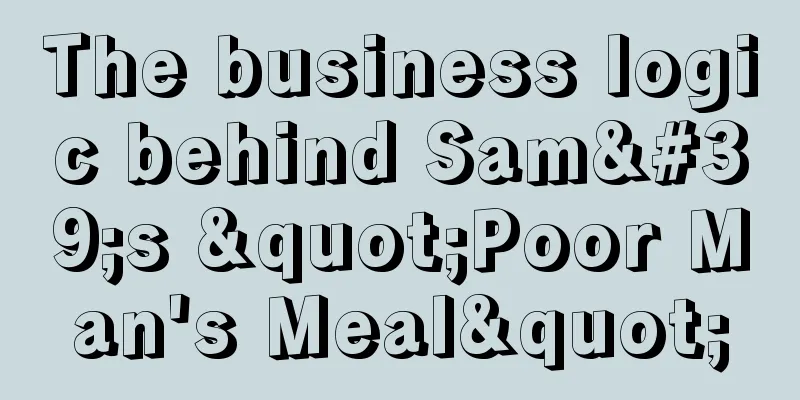Weighing assassins target young people

A dried plum costs 25.6 yuan; two bowls of spicy hot pot cost 175 yuan; six palm-sized pieces of handmade nougat, with a total price of 466 yuan... In recent times, news about young people being "stabbed" by weighing goods has frequently become a hot topic on the Internet. Unlike the "ice cream assassins" and "stationery assassins" who shock consumers physically and mentally simply because the price exceeds their expectations, the "weighing assassins" often clearly mark the price, and let consumers decide the specific amount to buy. However, the amount settled by weighing will still far exceed consumers' expectations. This kind of consumer experience that is caused by one's own hands makes most young people choose to swallow the loss even if they are "stabbed". Young consumers frequently fall into the trap of "weighing assassins". Is it because young people "lack common sense" or is it intentional by the merchants? Jingzhe Research Institute learned the truth through field investigation. 1. “Weighing assassins” are everywhereThe Jingzhe Research Institute visited and found that most of the stores called "assassins" by netizens are located in commercial plazas or shopping malls, with independent stores and open counters. Most of these stores use transparent containers to hold various bulk snacks, mainly preserved plums and candies, and the outer walls of the containers are affixed with price tags of the corresponding foods. Although all of them are clearly marked with prices, the price units used by these snack merchants are different from the pricing method commonly known to the public. When the Jingzhe Research Institute randomly visited counters of brands such as "Meizijun", "Huahuademeimei" and "Tiantianmeimei" in Shanghai, it was found that the price tags all marked the unit price based on 50g (i.e. "one tael") as the standard unit. *Price tags on a stall in a shopping mall/Photo taken by Jingzhe Research Institute In addition, some stores also set up secrets in the prices. For example, the price units of different products in the same store are not uniform. Some higher-priced candied fruits are priced in units of 250g (i.e. "half a catty"), with unit prices ranging from 65 to 80 yuan, while relatively low-priced ones are priced in units of 500g (i.e. "one catty"), with unit prices ranging from 60 to 70 yuan. This leads some customers to choose products with lower "marked prices" but higher "actual unit prices" without carefully checking the label units. At the same time, because the price is based on unconventional weight, consumers may misjudge the price of goods and spend more than their budget. When the Jingzhe Research Institute visited the Shanghai Darongcheng shopping mall, a consumer who had just bought gummy candies said, "I saw that most of the prices were more than ten yuan, and I thought it would only cost thirty or forty yuan to buy half a bag of candies, but when I checked out, it turned out to be more than a hundred yuan." In addition to the "price trap", some stores are suspected of forcing customers to buy and sell. In some stores where store clerks weigh goods, when consumers clearly state that they want goods at a specified price, the merchants will use excessive weighing and on-site sales to make the actual amount exceed the consumer's budget, and will not actively remind consumers until they scan the code to pay and realize that the actual consumption amount is much higher than their expectations. This is not an isolated case. When searching for "candied fruit" on Dianping.com, the ratings of candied fruit shops in Shanghai's Changning District all do not exceed 4.1 points (out of a total of 5 points). Many consumers said in their comments that they had encountered an "assassin", leaving comments such as "the non-stop sales pitch is overwhelming, and they even pour more candy" and "it's too expensive, one candy costs more than 20 yuan". *Price tag of a snack brand store/Photo taken by Jingzhe Research Institute Snack brands such as Yifen and Bestore that also use bulk weighing to calculate prices are relatively standardized. Not only do they use the more conventional 500g as the unit of measurement, but consumers can also choose the quantity to be purchased and weigh it. Throughout the process, consumers can have a more intuitive feeling about the weight of the goods they choose and make a rough estimate. Mr. Chen, who has shopped in both types of stores, said: "There is a big difference between looking with your eyes and weighing with your hands. In many stores, the clerk will take it and weigh it for you. It looks small but it is actually very heavy." Some consumers also reported to the Jingzhe Research Institute that they occasionally get shortchanged when buying fruits and vegetables. Xiao Jiang once bought four regular-sized corns at a vegetable market at a price of 6 yuan per catty. The on-site weighing results showed that the four corns weighed 5 catties, with a total price of more than 30 yuan. After returning home, she used a scale to verify and found that the actual weight was less than 3 catties. Since then, Xiao Jiang has brought a portable electronic scale every time she buys vegetables. 2. The “Weight Assassin” specifically targets young people?The Jingzhe Research Institute learned that among the consumers who were "stung" by weighing goods, young people accounted for the majority, and most young consumers, when faced with consumption amounts that exceeded their budget, would choose to accept it silently and then pay the bill. Xiao Li, born in the 2000s, shared with the Jingzhe Research Institute her experience of being "assassinated" by a spicy hotpot restaurant. In Xiao Li's opinion, compared with restaurants with gorgeous decorations, attentive services and located in large commercial areas, ordinary restaurants on the street will naturally be more affordable, but a "spicy hotpot meal costing more than 60 yuan" refreshed her perception. According to Xiao Li, she once bought a weighed spicy hot pot at a street restaurant with very ordinary decoration. The price in the store was 6 yuan/50g for vegetarian dishes and 8 yuan/50g for non-vegetarian dishes (i.e. 60 yuan per catty for vegetarian dishes and 80 yuan per catty for non-vegetarian dishes). Although Xiao Li clearly stated that she only needed two meatballs, the merchant gave her six or seven. After two rounds of negotiations, the merchant reluctantly reduced the number to three. In the end, she spent more than 60 yuan on four servings of vegetarian dishes and two servings of non-vegetarian dishes. "I don't know much about the settlement method of pricing by weight. In my understanding, one pound is equivalent to the weight of six or seven normal-sized apples. At that time, I thought it would cost more than 30 yuan at most." Xiao Li also said that when she asked to reduce the portion, the clerk's attitude was very bad and said, "How can I do business if everyone is like you?" She didn't dare to say anything for a moment, and when the merchant put the payment machine in front of her, she was embarrassed to lose face on the spot, so she finally reluctantly bought the expensive spicy hot pot. In fact, young consumers’ lack of awareness of weight-based pricing is also a consumption phenomenon unique to the times. In particular, Generation Z, who grew up during the rapid development of the e-commerce industry, has become accustomed to online shopping. In order to facilitate consumers’ purchases, e-commerce platforms have highly standardized products through fixed quantities and corresponding prices. Therefore, the younger generation of consumers does not need to observe the unit price, estimated quantity, and consumption amount of the product before making a decision. When encountering problems with products and after-sales service, young consumers also communicate with customer service through the Internet, which greatly caters to the actual needs of young people’s “social phobia” physique. The offline shopping scene of weighing and pricing, from consumption decision to communication, makes young people who are used to online shopping "panic". In Xiao Li's view, when she encounters unreasonable situations, she can persist in "confronting" with the merchants online and defend her rights to the end. But when she really communicates face to face, she often "dare not speak out". Considering the time cost and face, she will choose to be tolerant temporarily. Xiao Li believes that the emergence of "weighing assassins" is related to both merchants and consumers. It is precisely because many young people are not familiar with the concept of "jinliang" and do not pay attention to the unit of measurement when purchasing that merchants are able to "take advantage of the loophole." In addition, some young people have different ideas from the older generation. Instead of wasting time confronting merchants, they would rather use the Internet to expose the store to prevent more people from being "cheated." Xiao Jiang's view is slightly different. After being cheated when buying groceries, she would use her own scale to weigh the goods again whenever she bought bulk goods. If there was a large deviation, she would question the merchant on the spot. Xiao Jiang said: "Blindly tolerating will only make the 'unscrupulous merchants' more arrogant, and will 'scam' more consumers." In her opinion, although young people today are not as careful with money as their parents, this does not mean that merchants can "choose to serve people". Young people can avoid direct conflicts, protect themselves, and then use other methods such as bringing their own scales and calling the market supervision and management bureau to safeguard their rights. 3. High prices are not a sinIn 2022, Zhong Xue Gao became synonymous with "Ice Cream Assassin", and then "Assassins" appeared in many consumer fields such as fruits, stationery, stewed food, and plums. This word is also used by people to describe those products that look unremarkable but have unexpected prices. However, high prices are not the original sin of "Assassins" disrupting the consumer market. A netizen once posted a note on Xiaohongshu saying that she met a "chocolate assassin" and spent 105 yuan on six small chocolates that she selected and weighed herself. Many netizens in the comment section felt that it was not worth it for her. However, according to the Jingzhe Research Institute, the chocolate brand purchased by the netizen is the top Italian chocolate brand Venchi. As the "Hermes of chocolate", the brand's products are made from the highest quality raw materials and do not add preservatives. In order to ensure the uniformity of chocolate taste and quality, all chocolates of this brand are uniformly made in Italy and then sold all over the world. The high-quality raw materials and excellent production technology make the raw material and labor costs much higher than ordinary chocolate, so the price is also much higher than ordinary chocolate. The emergence of "assassin" products actually reflects the differences in consumers' perceptions of different products. For example, in the minds of some consumers, chocolate is just a snack to satisfy their cravings in their spare time. It cannot fill their stomachs, tastes similar, and has no special effects. It is not worth spending money on a hot pot meal to buy a few chocolates. For lovers, a box of chocolates may only have four or five pieces, but giving each other the "best thing" is far more important than the price of the gift itself. The real "assassin" products are those that do their best to raise the price. For example, the sky-high-priced plums that caused a heated discussion in July last year were branded "Shangyao Haifeng", and only 50g cost 160 yuan. According to information, the brand name was originally "Shanghai Mofeng", a copy of the Hong Kong local preserved fruit brand "Mofeng". Hong Kong Meifeng is a time-honored preserved fruit store in Hong Kong. It was founded in 1960. It has a unique formula and uses high-quality plum fruit ingredients. Although the price is relatively high, it is very popular among consumers. Later, the Hong Kong Meifeng brand issued a statement to refute the rumor that "Shanghai Meifeng" is not a local Hong Kong brand. Therefore, "Shanghai Meifeng" was renamed "Shanghai Meifeng", but the price is still high. In fact, consumers are not new to the "weighing assassin" phenomenon. The "sky-high priced cakes" previously attracted widespread attention from consumers. However, what people did not expect is that the "weighing assassin" has expanded to more offline consumption scenarios such as snacks, snacks, and fast food . Taking advantage of young consumers' lack of knowledge about the weight pricing method to seek more profits is the real evil of the "weighing assassin". In a free market, it is understandable that businesses pursue revenue and profits. However, a strange consumer phenomenon is increasingly appearing in the mass market: brands and businesses are divorced from actual consumption scenarios, and use various gimmicks other than products to forcibly raise product prices, squeeze the market, and make consumers passively accept high-priced goods - this is the case with "Ice Cream Assassins" and "Stationery Assassins". For offline consumption scenarios where "pricing by weight" is used, the lack of knowledge of the concept of "pounds" by Generation Z is not an opportunity for merchants to "get rich overnight", but an opportunity to promote industry change. Merchants should consider how to make consumers truly realize the value of their products, not just using unexpected prices on the bill to make young consumers feel "stabbed". Returning to the essence of business, relying on the offline consumption scene of repeat customers, what is really needed is to increase repeat purchases to achieve sustained and long-term revenue. Therefore, how to break the cognitive gap between young people and "weighing and pricing" is a question that businesses need to think about. Otherwise, the "Hermes of plums" without repeat customers will eventually be abandoned by young consumers. Author: Mu Yu Source: WeChat public account "Jingzhe Research Institute (ID: jingzheyanjiusuo)" |
>>: How far can an ordinary person's business go?
Recommend
Why is there a low volume of orders on Amazon? What should I do if there are few orders?
The purpose of opening an online store is to make ...
Whether it’s CPM or CPS, you should talk about brand ROI in the end
To build a good brand, the first thing is to run t...
10 Douyin travel products with over 100,000 users, all of which are money-making opportunities
Introduction: Spring outing season is here! This a...
With over 78 billion topic views, how did “Guizhou Village Super” go from being an instant hit to long-term success?
Why did "Guizhou Village Supermarket" go...
There is no top female star on TikTok
This article explores the reasons behind the lack ...
What factors make up the cost of cross-border e-commerce products? How to set prices?
Cross-border e-commerce makes profits by selling g...
18 yuan for 100,000 likes, the popularity of the live broadcast room depends entirely on brushing
This article revolves around the term "data b...
In creating a shovel for video accounts, is WeChat aiming at "Jianying" or "Miaoya"?
With the development of short videos, WeChat has a...
How much does it cost to buy a Shopee online store? Is it expensive?
There are many businesses that want to open a stor...
What is the difference between Amazon replenishment limits and warehouse capacity?
Merchants who open stores on Amazon will definitel...
Does Lazada require a credit card? Are there risks in paying with a credit card?
In the digital age, the rise of e-commerce platfor...
100 Keyword Predictions for 2023 | Technology and Metaverse (11-20): Integration, Positive Energy and Sustainability
WPP's brand Wunderman Intelligence released it...
One video generates 2 million yuan in revenue, but it is difficult for UP hosts to make content paid
Video platforms such as Bilibili and Douyin have t...
Single-day GMV of 416 million, who benefited from the World Cup on Douyin
This article deeply analyzes how Douyin, a life se...
How does Amazon search by image?
As an e-commerce giant, Amazon has been constantly...









